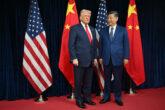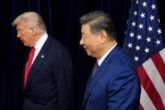September 04, 2018
Operationalizing US-India Strategic Cooperation
Bureaucracy may finally be catching up with rhetoric when it comes to U.S.-India cooperation.
The United States and India are poised to take a significant step toward institutionalizing bilateral strategic cooperation when their respective defense and foreign ministers conduct an inaugural “2+2” dialogue in New Delhi on September 6. The unprecedented 2+2 not only bears considerable symbolic value, but also stands as forensic bureaucratic evidence that the two governments are determined to find ways to operationalize comprehensive cooperation.
Every Indian prime minister in recent memory has rhetorically committed to ever more cooperation and alignment with the United States, but in practice, strategic convergence has lagged far behind. At the Shangri-La Dialogue in June, for instance, Prime Minister Narendra Modi highlighted the importance of promoting a common “rules-based international order” in the Indo-Pacific within which all nations can thrive as “equal and sovereign” entities — a decisive affirmation of the U.S. vision for regional security.
Notably, Indian strategists are adamant that the United States’ concept of a Free and Open Indo-Pacific Strategy also contain the word “inclusive” to ensure that it is framed as a broadly affirmative agenda for all countries in the region, rather than one aimed against any single actor. The reality is that, despite India’s reticence about provoking Beijing, considerable wariness of China’s coercive economic practices and growing military capability undergirds U.S.-India cooperation.
The United States has long considered India, a rising democratic power, to be a bastion of the liberal international order it holds dear, particularly in a region increasingly vulnerable to Beijing’s incursions. The George W. Bush administration’s landmark 2005 U.S.-India civilian nuclear deal was ultimately motivated by American conviction that a close partnership with India would be critical to sustaining a regional balance of power favorable to U.S. interests. In 2018, the U.S. Defense Department’s renaming of the U.S. Pacific Command to the “Indo-Pacific Command” highlighted the significance of India’s role in maintaining global stability and security. And the U.S. government’s reaffirmation of India’s status as a “Major Defense Partner” in the recently enacted National Defense Authorization Act (NDAA) for Fiscal Year 2019 cemented the importance of the U.S.-India defense partnership amid converging threat perceptions vis-à-vis China.
Read the Full Article at The Diplomat
More from CNAS
-
Chinese Maker of Bitcoin-Mining Machines Is a Security Threat, Says Expert
Bloomberg News reports that a Chinese manufacturer, Bitmain Technologies Ltd, that sells most of the world’s Bitcoin-mining machines — including 16,000 of them to a venture ba...
By David Feith
-
Indo-Pacific Security / Energy, Economics & Security
North Korea’s Provocations, Power Plays, and Shifting AlliancesTensions on the Korean Peninsula have reached a new and dangerous threshold. President Lee Jae Myung is warning of a real risk of accidental military clashes, as the situation...
By Dr. Go Myong-Hyun
-
Indo-Pacific Security / Energy, Economics & Security
How to Win the Economic War with ChinaTrump's approach to China has run aground, giving Beijing unprecedented advantage in the economic conflict....
By Edward Fishman & Julian Gewirtz
-
Indo-Pacific Security / Technology & National Security
Sharper: Tech + ChinaRecent talks between President Donald Trump and Chinese Communist Party General Secretary Xi Jinping placed a spotlight on emerging technologies, from high-end chips to minera...
By Charles Horn & Sevi Silvia




